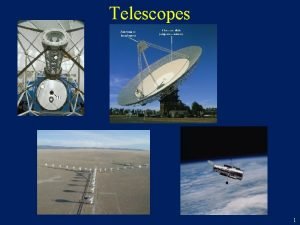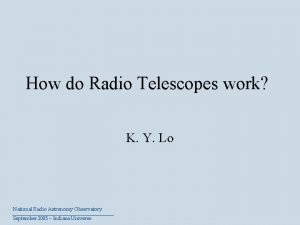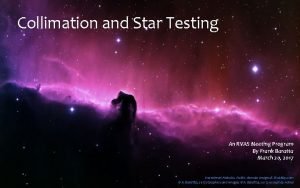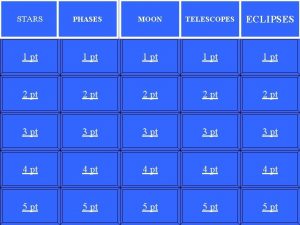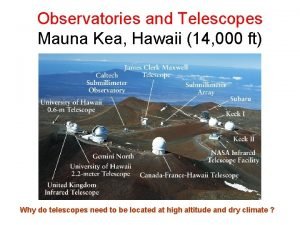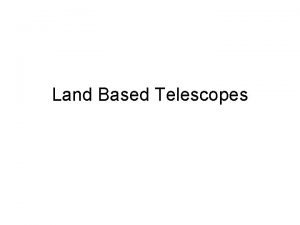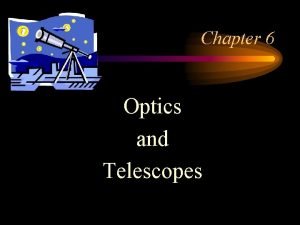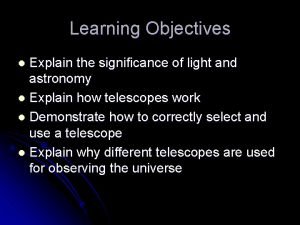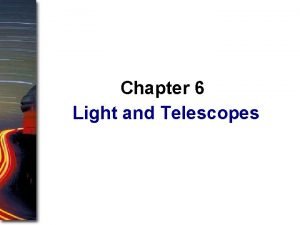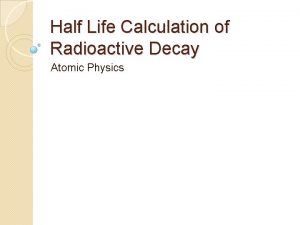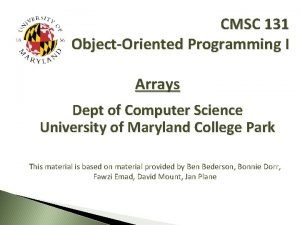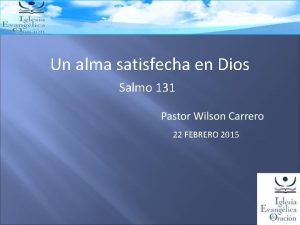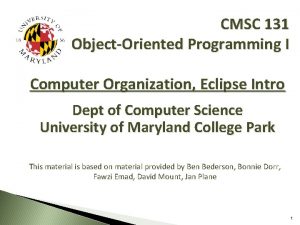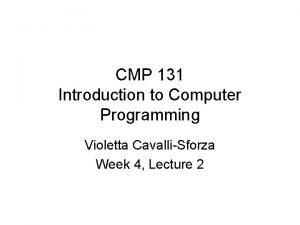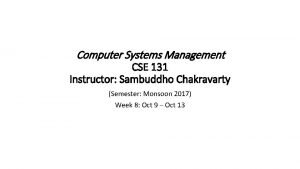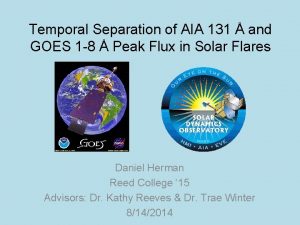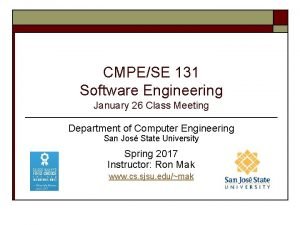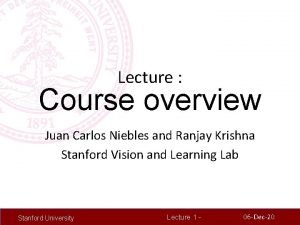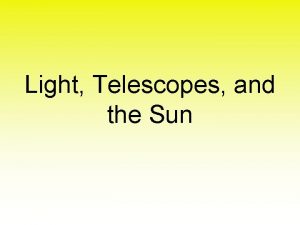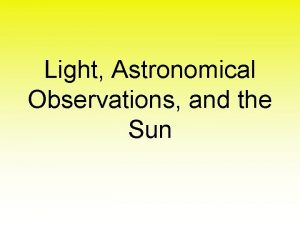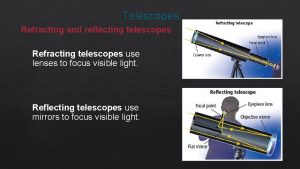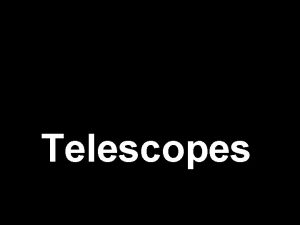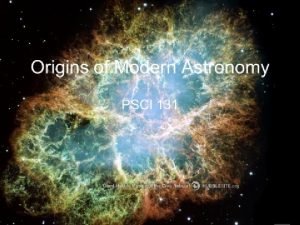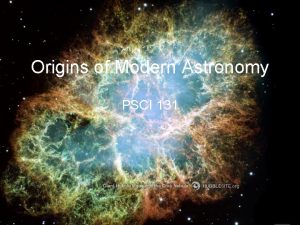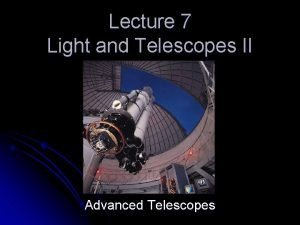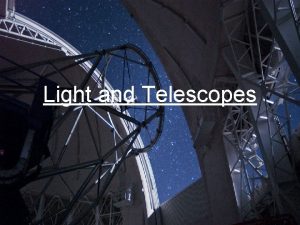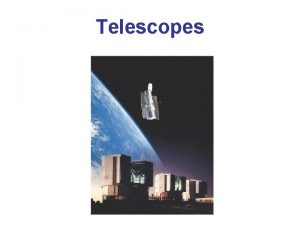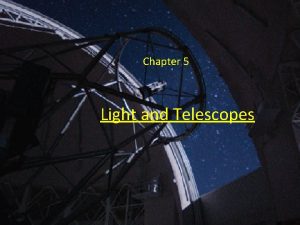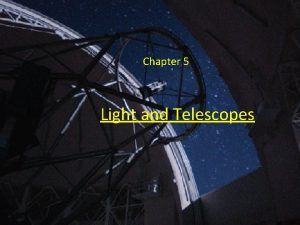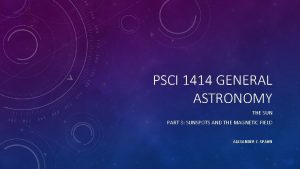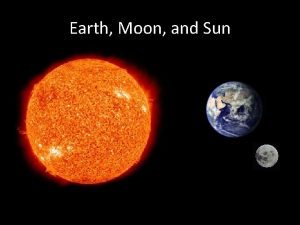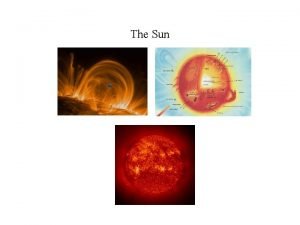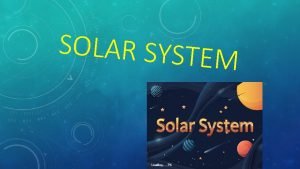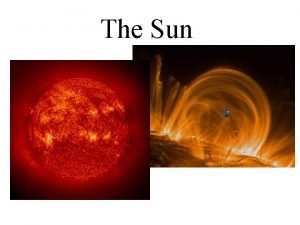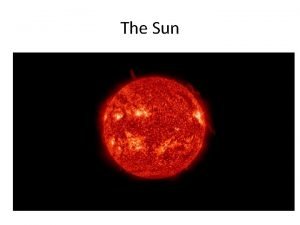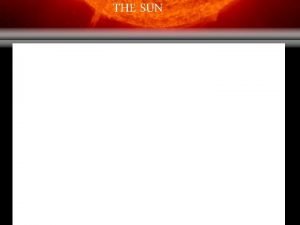PSCI 131 Light Telescopes The Sun Light Telescopes







































- Slides: 39

PSCI 131: Light, Telescopes, & The Sun Light, Telescopes, & the Sun Part Two • Optical Telescopes • Radio and Orbiting Telescopes • The Structure of the Sun

PSCI 131: Light, Telescopes, & The Sun Optical Telescopes

PSCI 131: Light, Telescopes, & The Sun Optical Telescopes • Gather visible light wavelengths • Concentrate it at a focal point, creating magnified image • Two types – Refracting – Reflecting

PSCI 131: Light, Telescopes, & The Sun Optical Telescopes: Refracting • Uses a lens (called the objective) to bend (refract) the light to produce an image • Light converges at an area called the focus • The eyepiece is a second lens used to examine the image directly – The size of the image produced by a lens is proportional to the focal length of the lens.

PSCI 131: Light, Telescopes, & The Sun Optical Telescopes: Refracting • Advantages – Inexpensive – Lens doesn’t have to be perfect to make a decent image • Drawbacks – Chromatic aberration: “halo” of color around image caused by refracted light – Chromatic aberration reduces image quality – If lens are too large, their weight will deform them and cause image distortion – limit to maximum telescope size

PSCI 131: Light, Telescopes, & The Sun Optical Telescopes: Reflecting • Uses a concave mirror to gather the light – Can be supported from the back because mirrors can be made thinner than lenses of similar size • No color distortion • Nearly all large telescopes are of this type

PSCI 131: Light, Telescopes, & The Sun Optical Telescopes: Reflecting • The primary mirror collects the light • The larger the primary mirror, the greater the light-collecting capacity. • Light gathered by the primary mirror is reflected to a secondary mirror. • The secondary mirror reflects the light to the focus, where the eye or instrument can observe it.

PSCI 131: Light, Telescopes, & The Sun Optical Telescopes: Reflecting • Advantages – No chromatic aberration – Can be very large, so higher magnification • Drawbacks – More expensive – Tiny flaws in mirror can greatly reduce image quality

PSCI 131: Light, Telescopes, & The Sun Large Telescopes • Larger light-gathering area – Total area of lens or mirror that gathers the light – Collect more photons of light, so can see fainter objects • Better resolution: sharper and more detailed images • Turbulence: the blurring and twinkling of astronomic objects such as stars caused by the movement of air in Earth’s atmosphere. – Observatories built on mountain summits to limit turbulence

PSCI 131: Light, Telescopes, & The Sun Resolution – 2 telescopes

PSCI 131: Light, Telescopes, & The Sun Technologies • Photographic films are used to detect ultraviolet and infrared wavelengths – Not distorted by human bias – Can expose for hours, recording more photons • CCDs (charge-coupled devices) – Large cameras that can collect almost all photons that strikes the chip • Greatly increases exposure time

PSCI 131: Light, Telescopes, & The Sun Technologies • Active optics: Motors drive telescope to compensate for distortions – Twin Keck Observatory telescopes in Hawaii use these • Arrays of telescopes (Interferometer) – Connecting telescopes into an array increases their resolution even more than their lightgathering area.

PSCI 131: Light, Telescopes, & The Sun Technologies • Even when located on mountain tops, advanced telescopes still face distorting effects of atmospheric turbulence. • Adaptive optics: Computer controlled mirrors cancel out atmospheric turbulence

PSCI 131: Light, Telescopes, & The Sun Radio- & Space-Based Telescopes

PSCI 131: Light, Telescopes, & The Sun Radio Telescopes • Gather radio waves from space – Pulsars, Quasars, Black holes • Collecting dish must be very large – Radio waves are about 100, 000 times longer than visible radiation – These signals are extremely faint • Can be networked into an array – Improves poor resolution

PSCI 131: Light, Telescopes, & The Sun Radio Telescopes • Advantages of radio telescopes – Less affected by weather – Less expensive – Can be used 24 hours a day – Detects material that does not emit visible radiation – Can “see” through interstellar dust clouds

PSCI 131: Light, Telescopes, & The Sun Orbiting Telescopes • Detect all forms of light – Atmosphere blocks much of EM spectrum • Radiation shorter than longest UV waves blocked • Water vapor in lower atmosphere absorbs most IR • No light pollution – Ex. The Hubble Space Telescope *

Space Observatories • Infrared – Cool stars, exoplanets, cool dust and gas of universe • Ultraviolet – Interstellar dust and gas clouds and hot young stars • X-ray – Black holes, quasars, high-temp gases – Chandra X-ray Observatory measured age of universe – 13. 8 billion years

PSCI 131: Light, Telescopes, & The Sun The Hubble Space Telescope • One of most important instruments in history of astronomy • Important discoveries: – Disks of dust are common around young stars • Supports nebular theory – Massive black holes exist at center of many large galaxies – Has allowed us to look further out (further back in time)

PSCI 131: Light, Telescopes, & The Sun Our Star: The Sun

PSCI 131: Light, Telescopes, & The Sun’s Composition • One of 200 billion stars that make up the Milky Way Galaxy • Only star close enough to allow the surface features to be studied • An average star in universe, but huge in our solar system – 100 x Earth’s diameter – 1. 25 million x Earth’s volume • Composition – Gaseous (90% Hydrogen, 10% Helium, others <1%) – Density: slightly greater than water (1/4 of Earth’s)

PSCI 131: Light, Telescopes, & The Sun’s Structure

How often do sunspots occur? Is there a correlation with magnetic storms on earth?

PSCI 131: Light, Telescopes, & The Sun Photosphere - Surface • “Sphere of light” • Sun’s “surface”—actually a layer of incandescent gas less than 500 kilometers thick • Grainy texture made up of many small, bright markings, called granules, produced by convection • Most of the elements found on Earth also occur on the Sun • Temperature averages approximately 6000 K (10, 000°F)

PSCI 131: Light, Telescopes, & The Sun Photosphere: closeup view *

PSCI 131: Light, Telescopes, & The Sun Chromosphere - Atmosphere • Just above photosphere • Lowermost atmosphere • Relatively thin, hot layer of incandescent gases a few thousand kilometers thick • Top contains numerous spicules—narrow jets of rising material

PSCI 131: Light, Telescopes, & The Sun Chromosphere From: astroguyz. com

PSCI 131: Light, Telescopes, & The Sun Corona - Atmosphere • Outermost portion of the solar atmosphere • Very tenuous • Ionized gases escape from the outer fringe and produce the solar wind • Temperature at the top exceeds 1 million K • Solar wind and Sun’s magnetic field make bubble called the heliosphere that extends past Pluto

PSCI 131: Light, Telescopes, & The Sun Corona (total solar eclipse)

PSCI 131: Light, Telescopes, & The Sun’s Interior • Cannot be observed directly • Sound waves are emitted, showing three distinct layers – Core: Region where Sun’s energy is radiated – Radiation zone: Above the core, dense zone where radiation is absorbed and re-emitted – Convection zone: Between radiation zone and photosphere, convection transports energy outward

PSCI 131: Light, Telescopes, & The Sun Source of Solar Energy • Nuclear fusion within core • Proton–proton reaction – Nuclear reaction that produces the Sun’s energy – Four hydrogen nuclei are converted into a helium nuclei – Matter is converted to energy – 600 million tons of hydrogen is consumed each second – Sun has enough fuel to last another five billion years

PSCI 131: Light, Telescopes, & The Sun The Active Sun

PSCI 131: Light, Telescopes, & The Sun Solar Energy • Most energy that reaches Earth results from steady, continuous emission of radiation from photosphere • Solar storms – irregular solar activity – Sunspots – Prominences – Solar flares – Coronal mass ejections

PSCI 131: Light, Telescopes, & The Sunspots • On the solar surface • Dark center, the umbra, surrounded by a lighter region, the penumbra • Dark color is due to a cooler temperature (1500 K less than the solar surface) • Follow an 11 -year cycle • Governed by Sun’s magnetic field • Pairs have opposite magnetic poles

PSCI 131: Light, Telescopes, & The Sunspots

PSCI 131: Light, Telescopes, & The Sun Prominences • Huge arching cloudlike structures that extend into the corona • Condensations of material in the corona

PSCI 131: Light, Telescopes, & The Sun Solar flares and CMEs • Solar flares – Explosive events that normally last an hour or so – Sudden brightening above a sunspot cluster – Release enormous quantities of energy • Coronal mass ejections – Eject particles that reach Earth in about one day and creates a magnetic storm that can affect radio transmissions – Causes auroras (the Northern and Southern Lights)

CMEs and Northern Lights

End of Light & The Sun Chapter
 Psci audit
Psci audit Pharmaceutical supply chain initiative psci
Pharmaceutical supply chain initiative psci Rovusastatin
Rovusastatin Light light light chapter 23
Light light light chapter 23 Into the light chapter 22
Into the light chapter 22 Chapter 22
Chapter 22 A building that contains one or more telescopes
A building that contains one or more telescopes How do telescopes work
How do telescopes work How do radio telescopes work
How do radio telescopes work Star collimation
Star collimation New moon telescopes
New moon telescopes Chromatic aberration affects reflector telescopes
Chromatic aberration affects reflector telescopes Modern telescopes make it possible for astronomers
Modern telescopes make it possible for astronomers Timeline of telescope
Timeline of telescope Land based telescopes
Land based telescopes All modern large optical telescopes are refractors.
All modern large optical telescopes are refractors. Significance of light
Significance of light Computer controlled telescopes
Computer controlled telescopes The design of modern x-ray telescopes depends on
The design of modern x-ray telescopes depends on Ortaklardan alacaklar
Ortaklardan alacaklar How to calculate half life physics
How to calculate half life physics Could 131g of xenon gas in a vessel
Could 131g of xenon gas in a vessel Phy 121 asu
Phy 121 asu Cogsci c131
Cogsci c131 Medical plaza miller 131 miller street
Medical plaza miller 131 miller street Cmsc 131
Cmsc 131 Psalm 131 vers 4
Psalm 131 vers 4 Salmo 131 2
Salmo 131 2 Phy 131 past papers
Phy 131 past papers Psalm 131 esv
Psalm 131 esv Mis 131
Mis 131 Cmsc131
Cmsc131 Violetta 131
Violetta 131 Cse 131
Cse 131 Pp-131
Pp-131 Aia 131
Aia 131 Ron mak sjsu
Ron mak sjsu Art. 131 cpc
Art. 131 cpc Cs 131 stanford
Cs 131 stanford Mis 131
Mis 131







